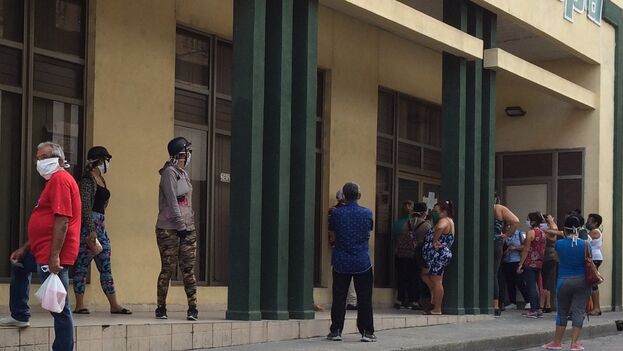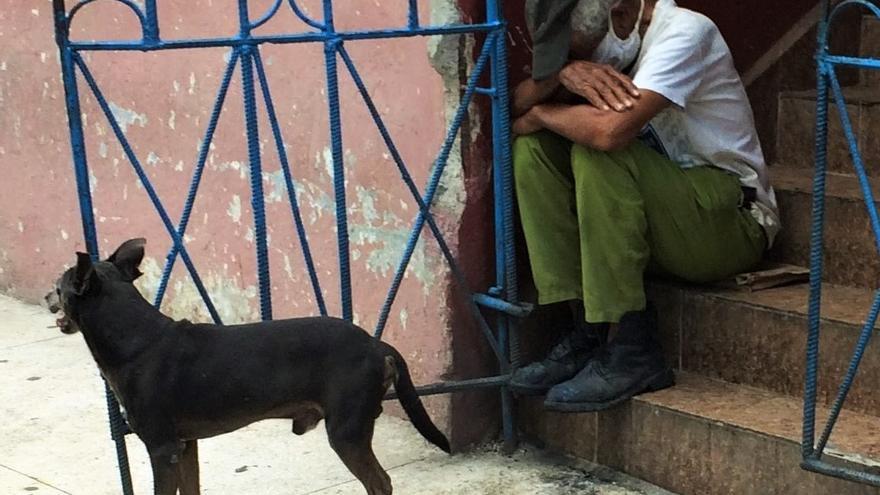
![]() 14ymedio, Santa Clara, Laura Rodríguez Fuentes, May 18, 2020 — Though its residents are still under lockdown, two long lines form every morning in the center of Santa Clara. One is for the Western Union office, where remittances are received. The other is for the Praga store, part of the Cimex chain, which is run by the Cuban armed forces and where cash exchanged for convertible pesos (CUCs) is spent.
14ymedio, Santa Clara, Laura Rodríguez Fuentes, May 18, 2020 — Though its residents are still under lockdown, two long lines form every morning in the center of Santa Clara. One is for the Western Union office, where remittances are received. The other is for the Praga store, part of the Cimex chain, which is run by the Cuban armed forces and where cash exchanged for convertible pesos (CUCs) is spent.
These days the line for Western Union is so long that, to be one of the first customers, a person has to get there at dawn.
Maria de la Caridad Cueto, who is among those most vulnerable to the coronavirus due to her diabetes, must leave home to collect the money her nephew sends her in order to feed herself.
She has twice been to the company’s Santa Clara branch without being able to collect the 120 CUC he has sent from Miami due to the number of people in line ahead of her trying to do the same thing.
“He works very hard over there and I have never asked him for anything but this time I had to accept it,” says Cueto as she stands alongside thirty other people waiting to get into the office.
“The first time I came, I waited for two hours before they told us the connection was down. I came again yesterday but I was sorry I did because there were too many people. I am diabetic and can’t go too long without eating something or drinking some water,” she laments.
Maribel Santana, a 35-year-old cook who lost her job at a restaurant due to the pandemic, did manage to collect the money from her wire transfer, but she was not as lucky in the line to the Praga store.
She got her 75 CUC but returned home with the full amount. “I went to the Praga store but there was nothing in the freezers,” she says. “Only cans of peaches and some really expensive items that are of no use and would never be considered part of a meal. Trinkets, just trinkets, and only the most expensive kind,” she protests.
Santana was a cook for several privately owned restaurants in the city but was laid off after the restaurant where she worked closed. She was left without any savings after paying to remodel and expand one of the bedrooms in her house so her 11-year-old daughter would have more privacy.
As luck would have it, I got help from overseas, but money is paper and you can’t eat paper,” says Santana. “Cubans have always known hunger and are afraid the refrigerator will be empty, as happened during the Special Period. Whatever savings I have now will go to buy bread flour to make and sell croquettes in my neighborhood in order to survive.”
Among the reasons for widespread shortages in hard-currency stores such as Cimex, Praga and TRD Caribe is the growth in hoarding and reselling.
By eight o’clock in the morning more than twenty people have formed a line in front of the Cimex store on the road between Santa Clara and Sagua.
They all know each other. They are members of a profession practiced in Cuba in times of extreme crisis or during hurricane season. Known as coleras,* they are mostly women who once sold imported clothing and food at private picnic sites.
The leader of the group, a young woman in her late twenties, carries a notepad in which she marks down the names of those in line and and hands a slip of paper to each person, indicating his or her “order of arrival.”
A store clerk comes outside to explain to the crowd that nothing has come in yet: “No oil, no chicken, no tomato puree, no soap.” She yells at them to disperse and threatens to call the police, who have not been there for hours.
The young woman in charge of the line is engaging in an illegal activity that could cost her a 3,000 peso fine or even jail time. But she seems not to be worried about the police.
She is unemployed and now organizes lines outside local marketplaces in her area. Though she does not agree to a taped interview, or to give her name, she is willing to explain how her “business” operates.
She says that when a delivery truck is on its way to a Cimex or TRD Caribe, the coleras alert their contacts and friends so that they and several of their family members can go to the store and get in line.

The most popular products are usually cooking oil, detergent and packages of frozen chicken.
“People’s places in line are allotted the day before, depending on the product, because that’s when you always find out what’s scheduled to arrive the next day,” says the woman. “Even if you only see a single person in line, there are always five more behind her because we assign our people their places in line.”
Most of those with the lowest numbers are involved in the hoarding or resale trade. They even advertise on social media and offer home delivery at very high prices.
To protect their identity, many resort to fake Facebook profiles. After taking orders from trusted customers, they deliver the merchandise to homes in Santa Clara. Generally, they ask that orders be placed through Messenger and do not often post their phone number.
In case a group member cannot be there on a given day, or one of her friends fails to show up on time, her place in line can be sold to someone who is not part of the so-called colera syndicate.
According to another woman who also wanted to remain anonymous, being female is an advantage because it makes them less vulnerable to the police.
“No policeman wants to get in the middle of this because if they physically attack us, it’s going to be bad news for them,” explains one colera, who feels protected by the group. If there is police violence, those present can film it and take photos as evidence in a legal challenge.
On several occasions President Miguel Díaz-Canel has called upon authorities to take serious action to curtail the illegal resale of merchandise. “These are people who are making the situation more complicated for us,” he says.
But other than filing charges or making a few well-publicized arrests, authorities do not routinely take significant steps to discourage resellers.
Under market regulation the only ways to get food without restrictions has been to buy from street vendors or to shop at “Hard Currency Recovery Stores” (TRD for the initials in Spanish), which only accept hard currency, such as Cimex and Caribe.
But after April they stopped selling merchandise that did not fall under the categories of groceries, cleaning products and items for newborns and toddlers such as diapers and feeding bottles.
In Santa Clara, the shop windows of these stores only display packaged or canned goods such as mayonnaise, olives, and fruit preserves.
None of these products solves the current dilemma of putting a traditional Cuban meal of rice, beans and some kind of meat on the table. Prices are also exorbitantly high for anyone earning the average Cuban monthly salary. A can of tuna costs 75 Cuban pesos (three dollars), a kilo of ham is six CUC (Cuban convertible pesos, roughly $6 US) and an egg goes for 45 cents in CUCs.
A recent document published by the Spanish Economic and Commercial Office in Cuba calculates that Cimex and Caribe stores operate on “retail markups of 180% to 240% of the cost of the product, a level of consumer prices well above those in Spain.”
These retail markups, imposed by the Ministry of Finance and Prices, have a very clear objective: they allow the State to “recover” the hard currency Cubans receive from their relatives abroad.
*Translator’s note: The term can be roughly translated as “women in line.”
__________________________
COLLABORATE WITH OUR WORK: The 14ymedio team is committed to practicing serious journalism that reflects Cuba’s reality in all its depth. Thank you for joining us on this long journey. We invite you to continue supporting us by becoming a member of 14ymedio now. Together we can continue transforming journalism in Cuba.
